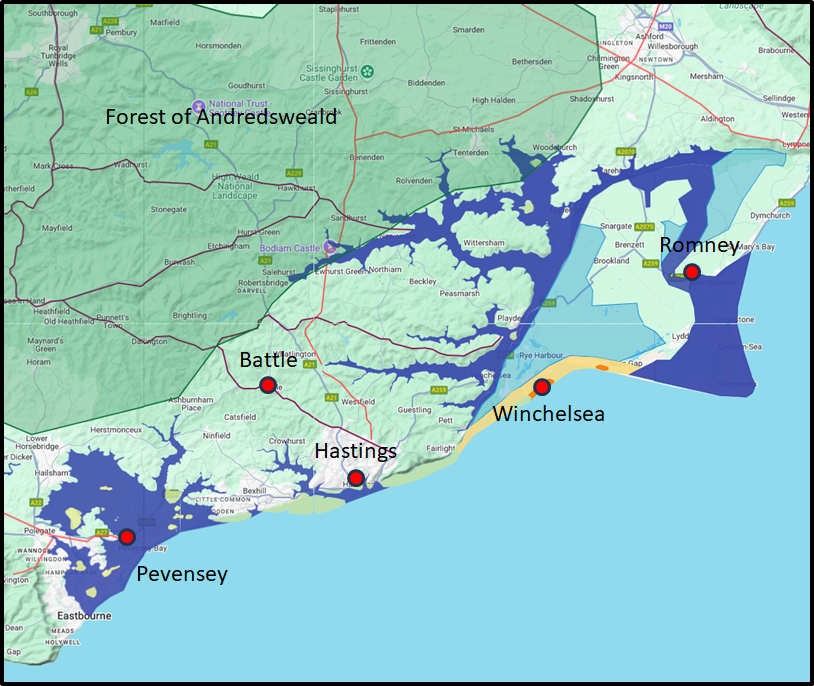|
 | Anglo Saxon History |  | |
| | Battle of Hastings 1066AD - F - The Coastline and Landscape |
|---|
|
| | The Coastline and Landscape ▲ |
|---|
I will try to explain the landscape of 1066AD from other research I have done, you may disagree with my conclusions, but
please read and see if I can convince you.
| 
This map is the end result of my current investigations into the landscape in 1066AD.
A quick overview, it would seem that the sea/high tide level was about 4.5 metres higher than the current level, this is
shown on the map in dark blue.
Please click on the following link to understand my logic for the sea/high tide levels being higher than today,
by using the Saxon island name snippet aeg.
Landscape - Was the sea level in Saxon times
at Pevensey 4 to 5 metres higher ? and also Landscape - High
Tide changes in the last 2000 years.
There was also the Forest of Andredsweald which appears to be identifiable using the location name snippet of
hurst and the Domesday locations which can be seen on The Great Forest of Andredsweald - Anglo Saxon
Chronicles.
The green areas in the sea are representations of the amount of land that has eroded since 1066AD, and the orange
area shows the shingle banks, with the yellow areas showing the islands of Old Winchelsea and Broomhill.
Landscape - The Cliffs of East Sussex and
Erosion 450-2024AD and Battle of Hastings 1066AD - H -
Landscape of Haestingaport
The changes in the Romney Marsh are implied with salt marsh shown in pale blue, if you wish to see more details
please click the following link Landscape - The History of
the Romney Marsh in maps(Pre-Roman to Modern times).
The forts shown are the Old Roman Fort of Anderida at Pevensey, and our understanding of the Saxon Burh at
Hastings Landscape - Alfred the Greats fort in
Hastings.
And finally the old Roman Roads(Ivan D Margary) are shown in red, and the old Celtic Ridgeways(Ivan D
Margary) are shown in Maroon All Margary Roads.
| | Other Potential Factors ▲ |
|---|
Senlac hill is mentioned in only one of the Chronicles from the time, the 'Gesta Normannorum Ducum'
written by Orderic Vitalis and does 'Senlac' really mean 'Blood Lake' or 'Sand Lake' is there another
explanation.
Battle of Hastings 1066AD - Senlac Hill where is it? and what might
Senlac mean?
Hecheland again only mentioned in one of the Chronicles, this time the 'Chronicles of Battle Abbey', the
single line of text could be interpreted as being the Battlefield, or prior to the Battle in 1066.
Battle of Hastings 1066AD Location - Hecheland where is it and
what does it mean ?
The Hoar Apple tree again only mentioned in one of the six copies of the Anglo Saxon Chronicles as the Saxon
mustering point before the battle, but was it Appledore ?
Battle of Hastings 1066AD - The Hoar Apple tree
The Saxon Shield Wall this is a much acclaimed defensive Saxon formation, but was this really true or is this
just a figment of a Victorian scholars imagination.
Battle of Hastings 1066AD - Observations - Saxon Shield Wall -
did it really exist?
The Malfosse named by the monks at Battle Abbey, but if it were just a story made up by the monks how is it that
at least four other chronicles mention a fosse ?
Battle of Hastings 1066AD Observations - Evidence for the
Malfosse
Yes the Normans sailed across the Channel, but can we identify their route, and is their route effected by the
landscape, I would like to think so.
Battle of Hastings 1066AD - E - The
Sailing - St Valerie to Pevensey
Williams Ship List does this list represent the size of the Norman Fleet ?
The Ship list of William the
Conqueror
Romney why did William destroy the town after the 'Battle of Hastings' ?
Battle of Hastings 1066AD - G - New Romney
| | |
|---|
| Conclusion ▲ |
|---|
The Hastings area is very isolated, and would have only been accessible via ships along the coast or
via the old Roman Roads and Celtic Ridgeways through the Forest of Andredsweald.
It seems a strange place to invade with cavalry unless something else was important in the area, please click the
following link for my thoughts Battle of
Hastings 1066AD - C - Why Hastings?
|
|
|
|
|
|
| |
|
|
Local Interest
Just click an image |
|
|
|
|
|
|
|
|
|
|
|
|
| |
|
|